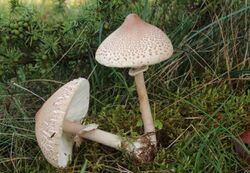Biology:Macrolepiota mastoidea
From HandWiki
Short description: Species of fungus
| Macrolepiota mastoidea | |
|---|---|

| |
| Scientific classification | |
| Domain: | Eukaryota |
| Kingdom: | Fungi |
| Division: | Basidiomycota |
| Class: | Agaricomycetes |
| Order: | Agaricales |
| Family: | Agaricaceae |
| Genus: | Macrolepiota |
| Species: | M. mastoidea
|
| Binomial name | |
| Macrolepiota mastoidea (Fr.) Singer, 1951
| |
| Synonyms | |
| |
| Macrolepiota mastoidea | |
|---|---|
| Mycological characteristics | |
| gills on hymenium | |
| cap is umbonate or flat | |
| hymenium is free | |
| stipe has a ring | |
| spore print is white to cream | |
| ecology is saprotrophic | |
| edibility: edible | |
Macrolepiota mastoidea is a species of mushroom producing fungus in the family Agaricaceae.[1][2]
Taxonomy
It was first described by many mycologists throughout the 1800s and classified variously as Agaricus gracilentus, Agaricus mastoideus, Agaricus umbonatus with each synonym then undergoing its own extensive period of reclassification.[1] It got its current name Macrolepiota mastoidea in 1951 when classified by the German mycologist Rolf Singer.[3]
Habitat and distribution
This species is found in Europe.[4]
Edibility
This is reported to be an edible species but it is noted that it can appear similar to some toxic Chlorophyllum species so caution is recommended.[4]
References
- ↑ 1.0 1.1 "Species Fungorum - Macrolepiota mastoidea (Fr.) Singer, Lilloa 22: 417 (1951)". http://www.speciesfungorum.org/Names/GSDSpecies.asp?RecordID=299971.
- ↑ "Mycobank Database - Macrolepiota mastoidea". https://www.mycobank.org/page/Name%20details%20page/name/Macrolepiota%20mastoidea.
- ↑ "Lilloa 22 (1949)" (in es-ES). p. 417. http://www.lillo.org.ar/journals/index.php/lilloa/issue/view/149.
- ↑ 4.0 4.1 "Macrolepiota mastoidea, Slender Parasol, identification". https://www.first-nature.com/fungi/macrolepiota-mastoidea.php.
External links
Wikidata ☰ Q206727 entry
 |

